Earlier in this blog we heard from Nishibe Susumu and Watanabe Shōichi. Now it is time to break out the list of the man himself, Kure Tomofusa, from his book New Techniques for Readers 読書家の新技術 (1987). Kure-sensei sorted his recommendations into categories.
Politics
Carl Schmitt, The Concept of the Political
Carl Schmitt, Political Theology
Carl Schmitt, Theory of the Partisan
Yoshimoto Takaaki, Tentative Proposals on Mathieu (A recommendation offered without comment in New Techniques, but in 2012 Kure-sensei reread Yoshimoto’s complete works and discovered that he had been deceived by the difficult style of writing, and in fact there was nothing interesting about them. I’m guessing he would rescind his recommendation.)
D. H. Lawrence, Apocalypse and the Writings on Revelation (Recommended as a supplement to reading the Bible.)
Carl Schmitt, Essays on Political Philosophy
Engels, The Origin of the Family, Private Property and the State
Lenin, State and Revolution
Yoshimoto Takaaki, Communal Illusions (Read instead Kure-sensei’s commentary on this book.)
The rest of the suggestions are not nearly as interesting… Read the rest of this entry »
Posted: March 15th, 2015 | Books
Just want to wind things down with a proper conclusion. The Kogakkan study program is a truly excellent one featuring top quality classes on Shinto and a lot of hands-on experiences. The teachers are really friendly and open to further discussion, and my supervisor Tamada-san as well as the other supervisors and volunteers were wonderful people who I hope to keep in touch with in the future. I’d recommend the program to anyone stumbling across this blog.
Here’s my summary essay (more like a summary blurb…), which is based on a presentation I gave to the school president and many other dignitaries.
I think it is important to understand the uniqueness of what foreign students learn on the Ise and Japan Study Program. In particular, I would like to say a word about the lectures and tours offered to us by Shintogaku professors. Shintogaku is an approach to thinking about spiritual culture that exists only in Japan. The primary purpose of Shintogaku is to train students to become shrine priests. But Shintogaku professors, through writing books about shrines and educating the general public, also create a common standard for practices at shrines across the country. When Japanese people go to shrines, they know what to expect. In this way, even as shrines are non-sectarian and welcome freedom of belief, they can continue to maintain their traditions for future generations.
When foreigners want to read about Shinto, it is very rare for them to run into Shintogaku. It is far more common to encounter the personal opinions of priests, new religious leaders, or foreigners who have been to Japan. Even the authors of textbooks about world religions can be led astray by these opinions. Japanese people may be surprised by what foreigners read about Shinto in English. My experience on this program, and during my other trips to Japan, has shown that true quality in talking about Shinto is best obtained by reading, talking, and thinking about why shrines exist in the way that they do.
From the Kogakkan professors who participated on this study program, I learned that Shinto has a very deep and complex history. Shinto has a unique perspective on how to preserve traditions and spiritual culture. Religious studies and theology are ill equipped to confront the types of discussion that take place within Jinja Honcho. In the 21st century, culture clashes, based on misunderstanding of the culture of other countries, are resurfacing and are already the cause of serious international conflicts. This is an important time for foreigners interested in Japan to collaborate with Japanese Shintogaku professors in order for the world to gain a new and enlightening perspective on human diversity.
Posted: March 15th, 2015 | Kogakkan
The past few days days have given us a little more free time, but actually the pace has been picking up as we begin work on our final presentations for Thursday. (I haven’t yet started work on mine.) Over the weekend we were given a free tour of Nara and Kyoto. I like this photo I took inside the hall of the Great Buddha.
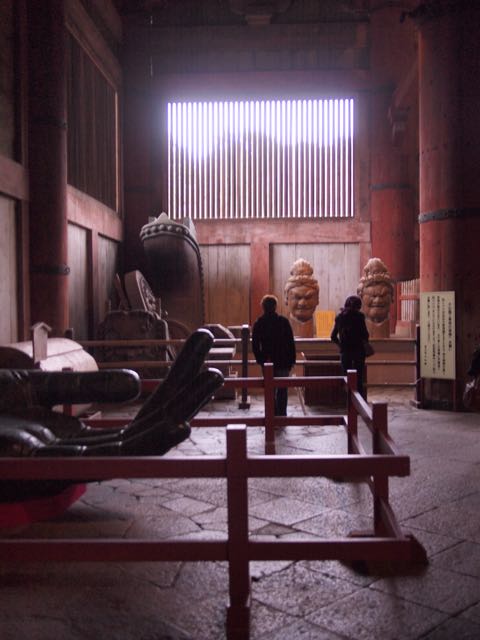
I can only offer a few thoughts about the outing to the mature port town of Oominato we had yesterday. The people of Oominato were overjoyed to have foreigners visiting, and everyone stepped out of their homes and were watching us as we walked down the street surveying the town. They used to build ships here, but it seems that people do not order so many ships anymore. There is a very beautiful-looking, 120-year-old ryokan in this town, a relic of a time when people would arrive on boats on their way to the Jingu. The ryokan seems to be completely empty now, which makes me sad because it’s kept in great condition and is very clean. Here are some pictures. Consider it for your visit to Ise!
Today we all enjoyed a tea ceremony. I got to go inside a tea house used in the full-formal ceremony, and inside I felt like I should be acting a lot more formally. You get the instinct that you need to know where to move for each step of the ritual. We then went into a half-formal room and had tea served to all of us, but the servers really did know what they were doing the whole time, and it was quite impressive.
We all tried to whisk the tea ourselves, but no one seemed able to accomplish it in the same way the servers had done it. I tried to take some pictures but they came out blurry. Agh
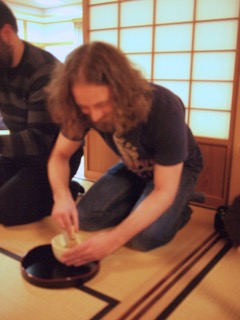

Time to get working on my final presentation!
Posted: March 10th, 2015 | Kogakkan
After the lectures today we went to an old-fashioned used bookstore full of extremely good-quality works of history, literary criticism, and philosophy. Micchan bought the Heike monogatari, Michael bought a full set of Biographies of Japanese Swordsmen, and I found some nice books by Kure Tomofusa. The owner did not charge me full price for them, even though they were only priced at 400 yen each. I reflected on this a lot as we walked back to the dormitory, and I believe that the only reason he could have done this is because he didn’t care about the price at all, but was simply happy to see so many foreigners interested in Japanese literature. This is a type of interaction that I will never have over Amazon.
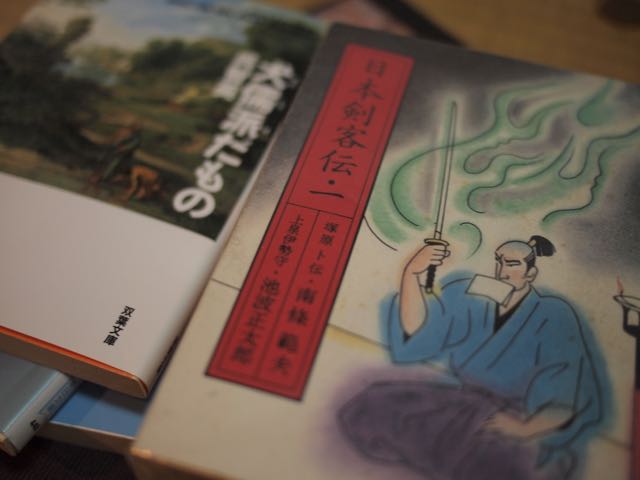
Without further ado, here are summaries of the three lectures!
Shimizu Kiyoshi
The gist of President Shimizu’s talk was that the Saiō symbolically brought the miyabi, or urban beauty, of the imperial capital to Ise. For a summary of his main point I will forward readers to Paula’s blog. I was much more interested in three tangents he went on:
(1) Why is the shikinen sengū necessary? He asked us to supply answers, and I gave him the standard answer that it’s because the kami like new, well-maintained buildings better than old buildings. He agreed, but then looked very expectantly to the room for another answer. He must have really expected more creativity from us! He then offered to us the possibility that the shikinen sengū teaches us a constant lesson about maintaining our mastery of difficult arts. The shikinen sengū creates something that is “newly old” (新しく古い). It therefore is a constant renewal and “revival” (甦り) of tradition. These days, the traditional crafts involved are so hard to come by that the implements for the shikinen sengū are often produced by “living national treasures”. But the renewal is about more than just the technology involved. The entire ritual must be constantly in the memory of the shrine priests, and the memory must be turned into action on a regular basis, once every 20 years.
(2) When Japan’s era name or nengō system was first introduced, said Professor Shimizu, they changed the name of the era whenever a good omen occurred, such as a great harvest or the appearance of a beautiful cloud. But by the later Heian period, the era was only changed when there was a bad omen, in order to ward off evil. The character of a nation changes with the times. Over the centuries, the Heian court became lax in its observation of the omens, and fell into depravity. Just like ancient Rome, the Heian aristocrats enjoyed endless parties as their political system began to decay around them. The Genji monogatari is a kind of high-water mark in the development of the classical court; a book that could not have been written in the Asuka or Nara periods, but which foreshadowed a decline.
(3) Ise is not the only religious institution in Japan that has been operated continuously since Asuka times. The Tōdaiji temple in Nara was built in in the early 8th century and has held a ceremony called shunie 修二会 nearly every year since 752. This year will mark the 1264th annual ceremony, which involves a traditional combination of Buddhist and Shinto rituals.
Sako Kazukiyo
Yamada Yoshio has been dubbed “the last national scholar,” but I believe we heard today from the last prewar scholar, Kogakkan’s director Sako Kazukiyo 佐古一洌. Unlike most of the other professors who spoke to us, Sako-sensei had no PowerPoint. Actually, his entire talk was a series of handwritten notes, and it quickly became evident he had never used a computer. He spoke in the highly educated and chauvinistic style of a prewar professor, which I found remarkably endearing, but also almost completely incomprehensible.
In place of an introduction, Sako-sensei shared with us some remarks about being old; he is 74, and as there are over 50,000 centenarians in Japan, he expects to live a bit longer. They are mostly women, though, so he amended this to say maybe he wouldn’t live that long. He said there was a method to beating senility named after the powers of 10. One must do the following every day: read one book, laugh 10 times, stretch 100 times, write 1000 characters (i.e. a letter to a friend), and walk 10,000 steps (一読、十笑、百吸、千字、万歩). To be honest this sounds like a great plan not just for old people but for people of every age.
Sako-sensei’s talk revolved around two points: (1) the Japanese spirit of magokoro, which I have written about in connection with the Genji monogatari, and (2) the Japanese tradition of matsuri, festivals. Matsuri is the expression of magokoro, and this is all that ever needs to happen in Japan. Unlike President Shimizu, Director Sako lives in a glorious, timeless state where the Japanese spirit and festivals are not subject to weathering and decay, but have simply always existed, and always will. He saw on television once that there are over 300,000 matsuri celebrated in Japan every year; therefore there are hundreds of matsuri taking place somewhere in the country every day. Contemplating this is clearly a great delight for him. He offered some words in praise of Minakata Kumagusu, who tried to stop the consolidation of shrines and save local chinjū-no-mori ecosystems back in the Meiji period.
The origin of these hundreds of thousands of matsuri was in desire for health, long life, marriage, safe childbirth, and worldly success. These are all expressed through magokoro, an honest heart. (Although he criticized the Chinese for encouraging selfish behavior in their philosophy, Sako-sensei’s definition of magokoro is rather Neo-Confucian, as I pointed out in my Genji paper.) Because women more often pray for the success of others, they have more pure hearts than balding old fools like Sako himself; this information came to him via his daughter. But regardless, Amaterasu commanded Lord Jimmu to create a country of people with pure and honest hearts, so it is the duty of every Japanese to avoid la négativité. In this one-hour talk, I am fairly certain that the only loan-word Sako-sensei employed was this one word “negatiibu“. The only thing he wrote on the board was the related phrase 神州清潔の民, “pure people of the divine country”.
Modernity was just a bothersome bit of foolishness to Sako-sensei, who whipped out a bit of English skills to quote Lincoln’s phrase “government of the people, by the people, for the people,” then replaced the Japanese word for “people,” jinmin 人民, with what he called its Edo period equivalent, ugō-no-shu 烏合の衆, making democracy the “government of the rabble, by the rabble, for the rabble.” The people of the Edo period had a better goal in mind: self-sufficiency, 自給自足. They were able to produce for themselves (自給), and they felt satisfied with what they had (自足). The complex world of democratic politics and technology is a mere distraction from the essentials of magokoro and matsuri.
Sako-sensei had saved the real tear-jerker for the end of his speech: a soaring anecdote about the end of the Pacific War. He was apparently completely unconcerned by the fact that the grandparents of his audience would have been fighting on the opposite side in that war; but in the end this didn’t matter anyway, because I am convinced that, since our Japanese friends were not listening to this talk, no one in the room understood a word he was saying at this point. The majority of his anecdote was a direct quotation of the way people spoke in 1945, which is basically Greek. So if my classmates are reading this and think I must be some kind of genius to have written down the whole anecdote, please rest assured that all I did was write down some misspelled names and dates and found the text he was quoting on the Internet.
On August 14, 1945, past 11 PM, after the Cabinet meeting on ending the war had adjourned, I [Hisatsune Sakomizu] entered the Prime Minister [antiwar navy admiral Suzuki Kantarō]’s office, and offered my thanks to him for taking on the challenges of that day.
We sat facing each other, and it naturally it was impossible to avoid crying. The Prime Minister sat across from me in pensive silence.
Unexpectedly, we heard a knock at the door. We turned to see Army Minister Anami [Korechika] enter with his sword equipped and his hat at his side. I stood and observed from the side.
The Army Minister walked directly to the Prime Minister’s desk and bowed respectfully.
“I said many things at today’s cabinet meeting, and I fear I must have caused some offense. I wish to humbly offer my apologies. My sole desire is for the protection of the national polity; I have no private motive. I beg your understanding of this.”
Seeing tears falling from Army Minister Anami’s face, I also began to cry. Then the Prime Minister, nodding in assent, rose to meet Army Minister Anami and said,
“I understand your intention, but Anami, the royal house will remain secure. No matter what happens, His Majesty will continue to personally and thoughtfully make offerings to the imperial ancestors every spring and autumn.”
Army Minister Anami said, “This I too believe.” He bowed deeply and departed.
After I saw him off at the door, the Prime Minister said, “Korechika came to say goodbye.”
I shall never forget that sight, as long as I shall live.
Anami Korechika committed seppuku later that night. But he died knowing that the matsuri would go on.
Kamo Masanori
Our last lecture of the day was from Kamo Masanori 加茂正典. He gave us the surprising news that the Saiō system was not the only link between the classical court and Ise. This was actually kind of comforting in a way, because I was wondering who actually was allowed inside Ise between 1300 and 1700. The Saiō didn’t come anymore, and the Emperor never visited… were the shrine priests and miko very lonely in there?
In fact there was another imperial messenger, called the Shiō 使王, who appeared even in the Nihon Shoki. Kamo-sensei seemed to have a poor sense of time and spent most of the hour explaining the divination system by which the Shiō was selected in the classical period. We heard that his main duty was to make offerings of silk and thread, but we did not get to hear about the rest of his job.
Unlike the Saiō system, the Shiō system continued throughout the Warring States and Edo periods, making it a hallmark 1150-year tradition that ended in… YUP, THAT’S RIGHT, 1871.
Posted: March 6th, 2015 | Kogakkan
At some point I’m going to have to write up all of the other things I’ve seen and done over the past four days. But for now, here’s a quick overview of the infrastructure that kept the sacred metropolis humming. Pictured here: the last remaining ryokan in Ise from before 1871, Asakichi 麻吉. Unlike the last onshi house, it is still operating, and is full of beautiful open spaces and antique calligraphy and porcelain, but it probably isn’t too popular with youngsters as it is quite cold in wintertime…
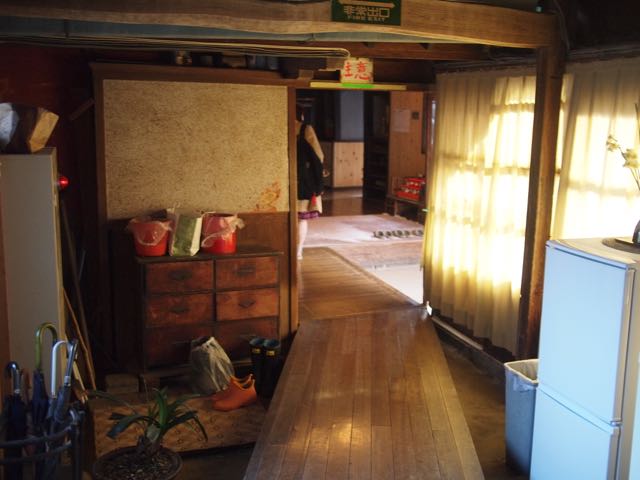
A constant influx of pilgrims and messengers to the Jingū meant a large population of employees and guests at the various onshi palaces and ryokan inns that had to be fed day in and day out, especially in Yamada, the Gekū area. With the rise of the onshi in the 1320s, a workshop and market area opened up in an area called Hatsukaichi (a name that means something like “Sunday Market”, from pre-medieval times). Hatsukaichi served not only the needs of the onshi, but also the Gekū itself, which needed to prepare food offerings for the kami every day. The merchants would sell their food to the Gekū in a building called the Korankan 子良館, which actually doubled as Japan’s first women’s college. Here, women were trained in ritual ceremony, which included the preparation of the sacred offerings. The Korankan was shut down alongside the onshi system in 1871.
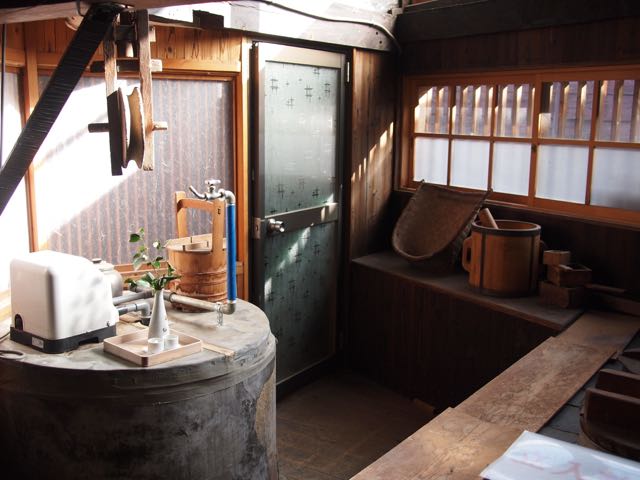
The amount of work that needed to be done was quickly too much for the confined space of Hatsukaichi, and from the 1400s more serious, large-sale operations began in a separate area called Kawasaki 河崎, which was conveniently located on a river between Yamada and the ocean. By 1620, the crafts and trades in this are were so well-developed that merchants came from China to sell top-quality goods. The finished products would be floated down the waterways to the Korankan as well as various onshi estates. A Japanese economic historian summed up this area by saying, “Kawasaki is the throat of Yamada” 「河崎辺ハ山田の咽喉」.
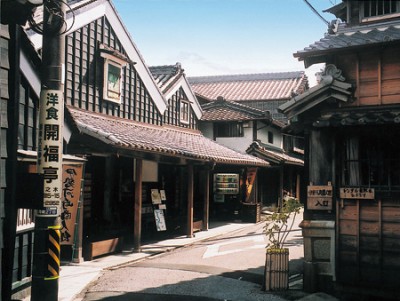
For the first few hundred years, business was done using bartering and imported Chinese coins, since the Japanese government was not in a good state to produce its own currency. In the early 1600s, someone in Yamada came up with the idea of paper money, perhaps based on seeing Chinese banknotes. As a result, the Yamada Triad of elders took charge of printing Japan’s first paper money, Yamada Hagaki 山田羽書, which was produced continuously for over 200 years until the Japanese government declared a monopoly on money production, again in 1871. It featured different colors for different values of money, and anti-counterfeiting techniques. Like the onshi records, the Hagaki banknotes are mostly destroyed today, so we don’t know when exactly the system began. Chieda-sensei has spent the better part of a decade hunting down old ones. Pictured below is a one-momme note featuring Ebisu, god of prosperity.

Because it relied on business rather than patronage, Kawasaki survived after 1871 and many of its picturesque workshops are still standing, although they are slowly being demolished. The area is now oriented towards tourists and you can buy all sorts of cool antique stuff, rare prints, and old books. If you are looking to take a leisurely walk through Ise this is probably the best neighborhood to do it in.
Posted: March 5th, 2015 | Kogakkan
While we learned about and visited a large number of places over the past few days, I’m going to use this post to focus on the subject of onshi 御師. The existence of pilgrimage promoters called onshi had been hinted at in previous classes, and I was under the impression that these people were something like travel agents. This was also the impression of our tour guide for today, who labeled onshi estates as “hotels”. In fact, as the medievalist Okada Noboru 岡田登 explained to us this morning, the name onshi is shorthand for the mind-boggling distance between the ancien régime of 1867 and the New Japan of 1877. Onshi were the literal center of pre-modern worship at Ise, and a key aspect of Japanese feudalism. In an age where the Jingū was closed to everyone but the Emperor, the population of Japan, rich and poor, registered themselves with religious gentry called onshi in order to forward their prayers to Amaterasu. In a word, the onshi were Japan’s First Estate, and Ise was once a sprawling, aristocratic Vatican.

I stole this illustration from a corporate magazine called Obayashi Quarterly, I hope they don’t mind. Pictured here is the estate of an onshi named Mikkaichi Dayū Jirō 三日市大夫次郎, which means something like “Joe, Lord Wednesday Market”, certainly not a name I’d associate with nobility. Some of the onshi had strange names; one of them was called Lord Dragon. Mikkaichi Dayū’s parishioners amounted to 350,000 to 500,000 households, meaning that he likely had over a million people on his rolls who exchanged their “first rice” fees (初稲料 hatsuhoryō) for the right to have prayers forwarded to the Jingū, and the possibility of staying at his estate and witnessing a kagura sacred dance if they were ever able to save up the money for a pilgrimage. Here’s the shocking thing; the kagura dance was not performed at the Jingū itself, but was in a special building towards the back of this estate. Furthermore, the ofuda talismans that onshi sold to parishioners were not from the Jingū, but were produced completely by the onshi, in their capacity as shrine priests. In short, the onshi were religious institutions providing the public’s sole line of access to the Jingū.
Pictured: The original stamp used by a Gekū onshi to produce ofuda, along with several examples. The sticks that one finds inside ofuda would also have been supplied in-house.
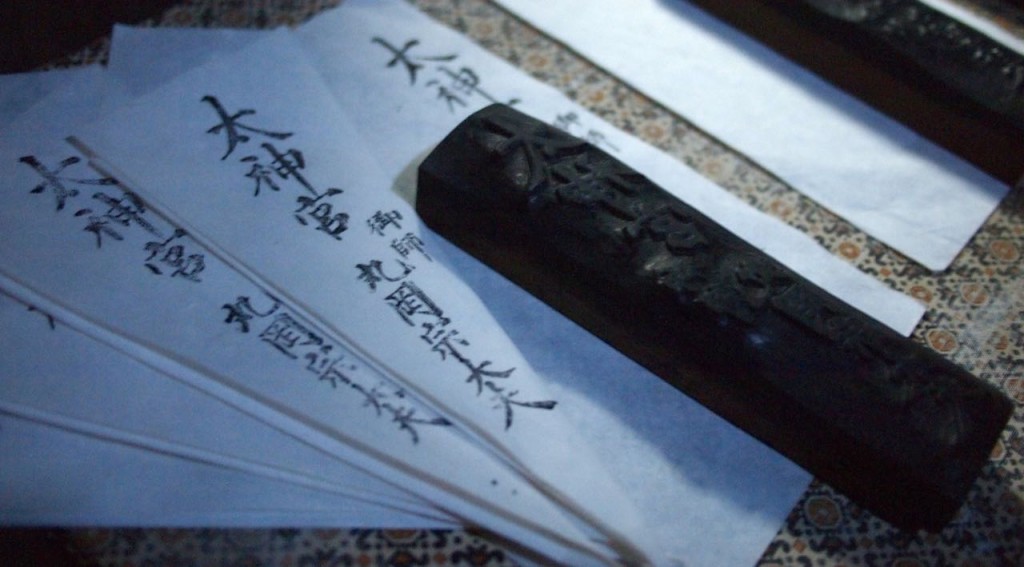
Okada-sensei painted a rather dire portrait of the state of knowledge we have about onshi. He expounded at length on the fact that nothing was saved when the onshi system was abruptly abolished in 1869. A system that had received the support of 80-90% of the Japanese population suddenly vanished, and all the gorgeous estates had no means of upkeep. Like the suddenly disinherited samurai Shiba Ryōtarō describes in Clouds Above the Hill, the onshi had no choice but to move away and find new jobs, but where samurai families had houses scattered across the country, everything the onshi had done was centralized in Ise, which instantly transformed from the noble headquarters of an established religion to a backwater fishing village. Hundreds of years of detailed records, detailing up to 700 years of Shinto customs, were generally sold to paper mills where they were turned into tissues and toilet paper. In many cases we do not know how onshi families came into existence or how they became chosen by their patrons.
Many of the abandoned onshi estates were turned into rubble when the Americans bombed Ise in 1945, and others were demolished in the postwar years due to their extreme age. In 2015 there is only a single onshi estate still standing in Ise. This is the Estate of Maruoka Sō Dayū 丸岡宗大夫邸, which happens to have been built in 1866. It is currently owned by the 18th Maruoka Dayū, Maruoka Masayuki 丸岡正之, who works as a carpenter. Maruoka receives no money from the city or prefecture to pay for upkeep on the estate. He does not make enough money to keep it open, but has spent many years keeping it intact and opens it up for special occasions, such as when a group of foreigners are visiting. He says that his grandparents loved the old house very much and preserved it when many other houses were left to rot.
Pictured: Micchan stepping into a front room.

As I said, the onshi system lasted almost 700 years. (General Electric and Disney will be quite lucky to last that long.) It began as a replacement for the Saiō, when the Saikū was falling into disrepair and the Imperial household was no longer able to provide the Jingū with reliable funding. In 1181, Minamoto no Yoritomo, the founder of the shogunate system, came to Ise personally and petitioned a 4th rank Gekū priest (konnegi 権禰宜) named Watarai Mitsuchika 度会光親 to make a prayer on his behalf. It was the first time in the Jingū’s 700- to 1100-year history that a prayer was offered on behalf of someone other than the emperor, and it was the first time someone from outside the Imperial family had come to Ise for that purpose. As far as legitimizing his authority went, Minamoto no Yoritomo was both bold and clever.
He was also a trendsetter. As more estates in Japan fell into private hands, leading to the feudal or manor system (荘園 shōen), emerging landlords dedicated portions of their land to the Jingū specifically, in order to get the same divine favor that Minamoto had secured. This land was called mikuriya 御園 “sacred manors” or mizono 御厨 “sacred kitchens,” i.e., places where offerings were prepared. Similar to the medieval Church, the Jingū ended up inheriting and possessing large amounts of land in this way. The Gekū priests who made prayers in exchange for these offerings were called on’inorishi 御祈祷師, or “sacred prayer teachers,” later shortened to onshi. A similar system was already in place at Kumano, and later many shrines and Buddhist temples had such teachers, usually called oshi outside of Ise.
By 1383, the Ise onshi were serving parishioners in every part of the country, from Ezo (Hokkaido) to Kyushu. The onshi multiplied into the hundreds and they began purchasing parishes from each other and fighting over patrons. As we learned way back on day 1, the communities they supported, called Yamada and Uji, were basically at war with each other from 1400 to 1600, causing the only interruption of the shikinen sengū in Japanese history. Three classes of people served as onshi. First came the officiating priests called konnegi, who were usually called Dayū 大夫 after their aristocratic rank and often called ji’nin 神人 or “god people” in written documents. Lower level religious functionaries, also able to offer prayers, were called shin’yakujin 神役人. Finally, ordinary merchants, through some intervention that Okada-sensei did not describe, were able to become onshi at some point; perhaps this was how we got to Lord Wednesday Market above. [edit: Chieda-sensei clarified that the merchants, including Maruoka Dayū, purchased their titles.] All levels of onshi had to employ bureaucrats fluent in all the different dialects of pre-modern Japanese, in order to grant prayers and do business with people from across the country.
Uji-Yamada was at last pacified, and the onshi system officially regulated, with the rebirth of the shogunate in the 1590s, and the system reached its peak in the 18th century. Every onshi was at the head of an enormous nationwide network that had its luxurious headquarters in the sacred city of Ise but went all the way down to itinerant travelers bestowing ofuda as they did their rounds in rural villages, and selling goods such as astrological calendars from Ise or beauty products (usually made from mercury… oops). As noted above, up to 90% of Japan’s 30 million people were members of an onshi group in some way or another; those with no membership at all were considered in a vague way to be outside the reach of civilization.
In 1724, the Gekū peaked at 615 different onshi lords, and in 1777, the Naikū had a much smaller peak with 271 onshi. Following this, the groups slowly consolidated their power. The Maruoka Dayū estate that we visited today contained rare surviving testaments to this power. First, we have this hengaku 扁額, produced to memorialize a kagura dance conducted by the onshi and his parishioners in 1865.
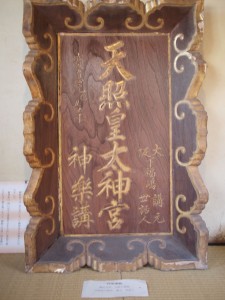
It looks like a pretty ordinary engraving on wood… but when our tour guide Chieda-sensei saw it, he remarked, “pretty bold!” Why is it pretty bold? Because it reads “Great Jingū of Amaterasu Ōmikami” 天照皇太神宮, but in fact, this onshi was serving the Gekū, which honors Toyouke Ōmikami, god of agriculture and food preparation, and most certainly not Amaterasu. The ofuda stamps at the Maruoka Dayū estate seem to testify that as the Amaterasu cult picked up steam in the mid-1800s, the onshi around the Gekū simply began proclaiming that they were authorized to offer prayers to Amaterasu. But this is something it’s impossible to know for sure, because so many records were destroyed. Now, some more proofs of power.
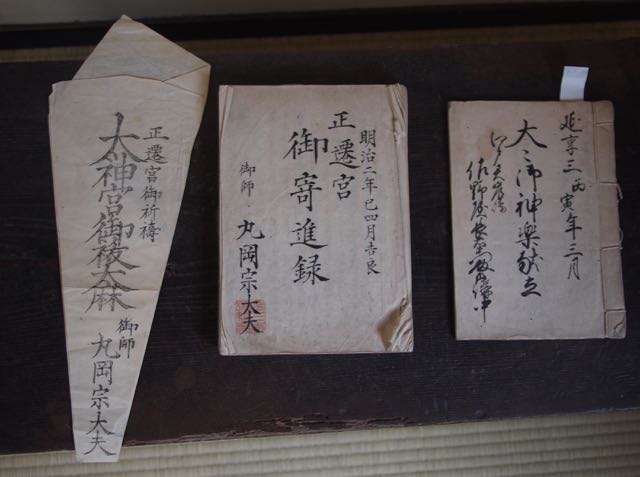
On the left here is one of these newer ofuda; it appears to come from the “Great Jingū” (Gekū? Naikū? Both?), but was actually produced on site by the Maruoka Dayū. [edit: According to Chieda-sensei, he was not supposed to be able to do this, since he was only a merchant and not a priest. But Maruoka-san insisted that his ancestors made the ofuda themselves. Another mystery.]
Next to the ofuda is a very long list of people who gave money to the onshi in honor of the shikinen sengū (the money did not pay for the sengū itself, but apparently they simply solicited every time this happened). On the right is the reward provided to parishioners who came to Ise: a travel schedule for a deluxe package pilgrimage, with three days of meals and events surrounding the kagura dance. This may look like gross profiteering from a modern perspective, but in fact this onshi was performing a sacred duty for his parishioners. He was their link to the Jingū, as they were not allowed inside themselves. Only after the abolishment of the onshi system in 1871 were the gates opened and a kagura hall built inside the Jingū itself. By the way, if you go to Ise to see a kagura today, you will see it performed by beautiful young women. But the dance you would have seen at an onshi estate up until 1871 would have used older women, often in their 50s and 60s, with decades of practice.
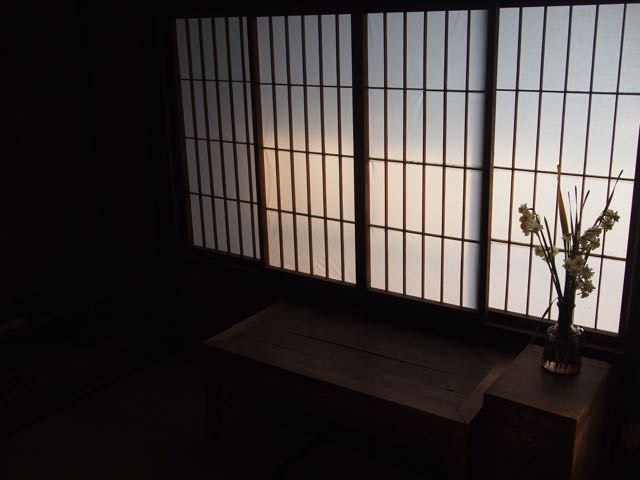
Ten luxurious gates of a style reserved for titled gentry are scattered here and there in the city of Ise, along with a few beautiful antique rooms comprising the partial remains of the Maruoka Dayū estate, and that is all that remains of the onshi system that once ruled this city. Once, Maruoka Dayū boasted a nationwide network, but now his heritage is hanging by a thread; the building seems ready to collapse, and the government will not pitch in for this last testament to 700 years of history. The friends of the owner have set up a Facebook page to encourage people to preserve the estate, and that’s about it.
Posted: March 4th, 2015 | Kogakkan
Today I will be making an intensely specialized post about a lecture I heard today from Professor Shirayama Yoshitarō 白山芳太郎先生. If you are reading this via RSS you may want to skip this post. It’s for my own records or something.
Shirayama-sensei had a bit of a surprising alternative theory for us about the shinbutsu bunri 神仏分離, early Meiji period separation of kami and Buddhas. The common theory about this is that it was an official persecution of Buddhism. This is a very serious theory, enforced by books like James Ketelaar’s Of Heretics and Martyrs in Meiji Japan, a defining work in Japanese religious studies which is immediately recognizable to a scholarly reader as being grounded in an intimidatingly deep level of research. Shirayama-sensei’s counterproposal was that, in fact, Shinto was more persecuted than Buddhism, simply by looking at the numbers: during the shinbutsu bunri, shrines were more likely to be shut down entirely than temples, and kami-worship within Buddhist institutions was not targeted, while Buddhist worship within shrines was targeted. If we consider Shinto to be “what goes on inside a shrine,” a shrine being a place run by a shrine priest, the counterintuitive result is that the destruction of Buddha statues was in fact a persecution of Shinto. This puts the following example passage from Ketelaar in a totally different light:
After a brief pro forma exchange of documents with the Office of Shrine Affairs within the Enryaku-ji, the Tendai temple that until the promulgation of these orders had administered the shrine, Juge and his band of self-proclaimed “restorationists” (fukkosha) proceeded to remove every statue, bell, sutra, tapestry, scroll, and article of clothing that could even be remotely linked to Buddhism from the shrine complex. All inflammable materials were gathered together and burned; all metals were confiscated to be refashioned into cannon or coin; stone statues were decapitated and buried or thrown into the nearby river; and wooden statues were used for target practice, or their heads for impromptu games of kickball, and then burned.
That’s from Of Heretics and Martyrs in Meiji Japan, page 9. (ISIS would be proud!) Ketelaar’s narrative reads this as Shinto ideologues destroying Buddhist cultural heritage. But Shirayama-sensei reads it as political ideologues– essentially, Confucian nativists– wrecking and burning a Shinto shrine.
What discursive value do we gain if we adopt Shirayama-sensei’s alternative categories? He provided us with the concrete example of Kume Kunitake, an episode I’ve found bewilderingly paradoxical. In 1892, Kume theorized in an academic journal that “Shinto is the ancient custom of revering Heaven.” He wrote:
Probably Shinto does not qualify as religion; therefore it lacks a center of moral guidance, and is merely the reverence of Heaven.
「葢神道は宗教に非ず、故に誘善利生の旨なし、只天を祭り。」
This essay was reprinted in a magazine with much wider readership, whose nativist readers complained that Kume was generalizing the unique regalia of the Emperor and got him fired from his university post. But here’s the very odd thing: legally speaking, Shinto was not supposed to be religion at this time, but was officially declared the common customs of all Japanese people. Shrines were barred from performing funerals, shrine priests were not allowed to preach, etc. So it is unclear who Kume was arguing against. Yamazaki Minako 山崎渾子 has spoken of this episode as one requiring further rethinking.
Shirayama-sensei proposed to resolve the paradox with two basic lines of argument (which he clarified for me after his presentation):
- In fact the majority of intellectuals at the time shared Kume’s basic sentiment. He was fired only for stating it publicly. The proof of this is once again in the irrefutable statistic that the enlightened intellectual elites of Meiji discouraged shrine work to an extent never seen before in Japanese history, and demolished half of the shrines in the entire country.
- In the Edo period, Shinto really was a religion, or a tradition/teaching, to use the contemporary terminology. It was described in Edo intellectual literature as one of the “three teachings” 三教 of Japan, and it had its own rituals, specialists, schools and texts. In the Edo period, shrine priests refused to do business with Buddhists and conducted their own funerals. So, Kume’s argument was actually doing the work of the state in denying the Edo period narrative; he simply rewrote the argument the Meiji state was making in an overly frank way.
Where Shirayama-sensei’s theory gets confusing itself is when he tries to tie in Western scholars: Chamberlain, Aston, and D.C. Holtom were all said to be similarly demeaning to Shinto. Like Kume, Holtom wrote that “what may be called an inner sense of religion is unfortunately conspicuously absent” in writings about Shinto. But Kume’s ultimate objective was the same as the government’s: to preserve Shinto in a “restored,” “primitive” form as an instinct for reverence for the Emperor. Holtom’s objective was quite opposite to this: he saw Shinto as having some kind of religious seed which, if properly nurtured, would mature into something like Protestantism. I outlined this in detail back in 2010.
For Shirayama-sensei, regardless of the motives of each individual scholar, the end result was the same: Shinto was thought of as being valueless from a religious perspective from 1868 to 1945; accordingly, much of what existed in the Edo period was lost. I think there is something to this, when you consider that alternative schools of Shinto were banned and many shrines were demolished. [edit: I sent Shirayama-sensei this post, and he made an even stronger claim: he said that in fact no schools of Shrine Shinto exist today, and all that is left to us are the invented traditions of government bureaucrats playing at being shrine priests, and the various sects. Scholars familiar with our deep lack of knowledge about Edo period schools may want to agree with this, although I’ve heard rumors that some Edo schools continued on in various forms.]
On the other hand, long before 1868 there was an intellectual quest for finding value in Shinto, and it ended with Kokugaku and Mitogaku, which led directly into the modern period. The Confucian nativists attempted to harness the gods, but the Song Confucianist Zhang Zai 張載 described gods as the result of qi gathering, and the sage Zhu Xi warned that “qi is strong and principle weak”. 「気強理弱」朱子語類巻四性理一
Maybe the conquering will of the gods overpowered those who wanted to seek out principle, and now all we have are the embers of something the whole world once saw burning bright.
Posted: March 2nd, 2015 | Kogakkan
Today I accomplished two things:
1. I went to the library and established to my own satisfaction where the Uhō-Dōji 雨宝童子 statue came from. The statue is a late Heian forgery attributed to Kūkai. It’s associated with a document called 「雨宝童子啓白」, also attributed to Kūkai, that claims that the statue portrays the incarnation of most of the ancient Shinto gods, including Amaterasu. Later, this portrayal was associated with Amaterasu specifically, which is the connection that became prevalent in the early Edo period. More details about this can be found in an abstract I translated, below the picture of fried chicken.
2. I had lunch with a random stranger who chatted me up in English outside a restaurant. He told me about the Three Great Soul Foods of Ise, which are legendary with the local people. They are the Spaghetti of Mori Cafe, the Dry Curry of Kitchen Cook, and, pictured below, the Fried Chicken Bowl of Manpuku Diner.
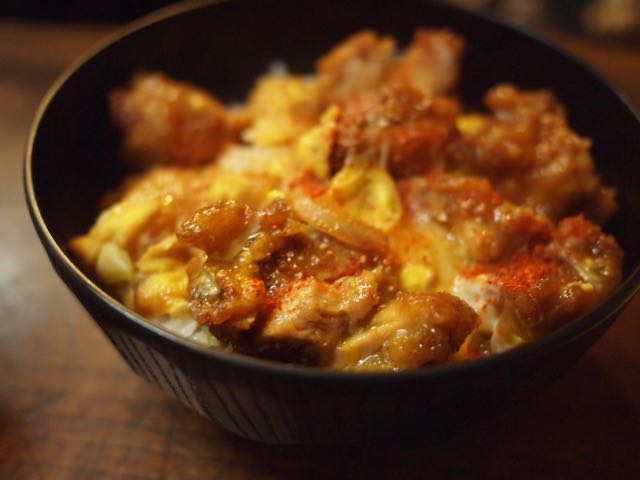
Now I will translate the abstract for a very good article:
鳥羽重宏「天照大神の像容(イメ-ジ)の変遷について–女体像・男体像から,雨宝童子像にいたる図像学」 皇学館大学神道研究所紀要 13 (1997), 119-179
ABSTRACT
In present day depictions such as publications, Amaterasu Omikami is generally drawn as having hair that hangs down richly, plain dress (generally white), a chest adorned with jewels, and a mirror in her hand. But originally, Japanese kami were not depicted in this way, and when we trace depictions of Amaterasu Omikami back through the ages, from the descriptions in the 記紀 [as well as supplementary Heian materials] we can guess at a female form, then in the Heian period a theory of male form appeared, while according to 本地垂迹説 she was given a Buddhist image, and in the early modern period images of 雨宝童子 became popular. Any and all of these forms, though, while they may have changed slightly, continued to exist until the beginning of Meiji. Out of all of these, the 雨宝童子 image, which became widely known through the efforts of the prevalent pilgrimage site 金剛証寺 near the Jingu, bears a 5-layer pagoda on her head, a pearl ball in her left hand, and a treasure-pole in her right hand. With the passing of the ages we begin to see the treasure-pole as a sword, and the ball as a mirror, and jewels adorning her chest. This is in accordance with better knowledge of the mythology, and can be seen as the beginning of the solidificaion of people’s images of Amaterasu Omikami. According to the influence of this 雨宝童子, we images of the gods wearing [specific kinds of ancient Chinese dress] become common. The image later being reimagined as a hatless and white-clad form, we may be said to have arrived at the present day.
Posted: March 1st, 2015 | Kogakkan















